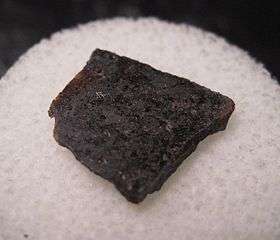Angrite
Angrites are a rare group of achondrites consisting mostly of the mineral augite with some olivine, anorthite and troilite. The group is named for the Angra dos Reis meteorite.
| Angrite | |
|---|---|
| — Group — | |
 A slice of "NWA 2999". Note the similarity to a terrestrial basalt. | |
| Compositional type | Stony meteorite |
| Type | Achondrite |
| Parent body | Possibly 289 Nenetta, 3819 Robinson or Mercury |
| Total known specimens | 12 |
Angrites are basaltic rocks, often having porosity, with vesicle diameters of up to 2.5 centimetres (0.98 in).
They are the oldest igneous rocks, with crystallization ages of around 4.55 billion years.
Origin
By comparing the reflectance spectra of the angrites to that of several main belt asteroids, two potential parent bodies have been identified: 289 Nenetta and 3819 Robinson. Other scientists have suggested that angrites could represent ejecta from Mercury.
Notable meteorites
There are currently 12 meteorites classified as angrites. The type specimen, the Angra dos Reis meteorite, was an observed fall in 1869 and at 1.5 kilograms (3.3 lb) is the fourth-heaviest angrite. The three largest are D'Orbigny (16.55 kilograms (36.5 lb)), "Sahara 99555" (2.71 kilograms (6.0 lb)) and "NWA 4931" with 2.14 kilograms (4.7 lb).[1]
See also
External links
- D'Orbigny Angrite - Meteorites Australia
- Angrite Micro Visions - Thin section pictures of angrites.
References
- "Meteoriticial Society Database". Meteoritical Society. Retrieved 2 January 2013.